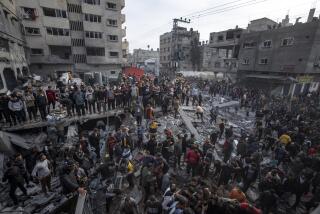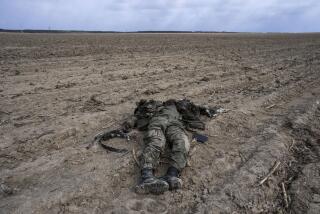‘Body Count’ Now Is of Tanks, Bridges : Numbers: The tolls so familiar from Vietnam no longer apply as the air bombardment continues.
- Share via
WITH U.S. FORCES, Saudi Arabia — For Army commanders here, this remains a war of numbers, a battle in which progress is gauged through bland statistics used to monitor the destruction of Iraq as the American air bombardment continues.
The recitation of tanks destroyed and bridges bombed, circulated among field officers almost every day, reduces war to sums and fractions, an arithmetic approximation of the erosion of the enemy.
To some, the ever-mounting estimates of Iraqi battle damage seem an all too familiar reprise of the systems-analysis of Vietnam, where a fascination with enemy casualties obscured the broader truth of a gradual American defeat.
“Sounds like body counts all over again,” an officer grumbled.
But in this phase of the ground-war preparation--well-insulated from combat itself--the U.S. commanders say the attention to raw numbers reflects the best way they have to gauge the power of the Iraqi army they expect to fight.
“There’s merit to counting what’s out there,” Col. James C. Riley, commander of the 3rd Brigade, 3rd Infantry Division, said in an interview the other day, as reports claimed that newly focused bombardment had inflicted heavy blows on some Iraqi ground units.
“Body counts got a terrible reputation in Vietnam,” Riley said, “but, really, the interest here has nothing to do with body counts. It has everything to do with measuring enemy strength. And that has real validity to our mission.”
The keen attention to the numbers, awaited eagerly by ground commanders whose desert headquarters are often no more than dusty tents erected behind an armored command vehicle, reflect a sense of certainty that they will be called upon to complete the destruction of the Iraqi army, the fourth largest in the world.
“What’s it going to take to make that guy give up?,” asked Lt. Col. Bill Reese, commander of a cavalry squadron assigned to the 1st Armored Division. “I think that it’s going to take going over there and killing them all--kill all the right guys, anyway.”
Only fairly general estimates of enemy battle damage have so far been made public.
But American officers here say the statistics they see have been extraordinarily precise, with almost daily updates, for example, of what is said to be an Iraqi transportation network only 10% intact.
Among the targets understood to be destroyed are two railroad bridges across the Euphrates River that carried 11,000 tons of military supplies into Kuwait every day--more than half the total needed to sustain Iraqi forces there.
Other statistics known to be monitored include percentage measurements of the destruction of Iraq’s command and control structure and the country’s power generation system, now believed to be operating at about 75% capacity.
Officers insist that scant attention is paid to “body counts,” with the number of Iraqis soldiers killed regarded as a still-uncertain figure of relatively little importance.
Instead, commanders say they focus on the toll of tanks and armored vehicles, cheering each subtraction from prewar strength.
“I think the long pole in his tent is sustainment of his force,” said Riley in emphasizing the importance of monitoring of enemy strength. But, he added, “once you cut him off, then you get into the business of destroying him.”
In what the officers said had helped squelch lingering skepticism about air-war battle claims, the daily estimates of damage to Iraq are said to be cautious, with no “kills” confirmed until authenticated by photographs.
Even the effects of bomb and missile strikes monitored from the air remain listed only as “estimated” until a follow-up report is completed, the officers said.
But the black humor in the damage summaries also demonstrates a detachment that underscores the disparity between U.S. Army headquarters, preparing for war, and the Iraqi foes, already enveloped deep within.
On one day last week, a report told of providing Iraq an “aircraft identification lesson,” as an artillery unit, caught out in the open, was subjected to heavy bombardment from American warplanes.
Another described a tactic in which an aerial leafletting campaign warning Iraqi forces to “Get Out of Dodge” was followed up the next day with bombardment from a fleet of American B-52s. The message of their 2,000-pound bombs, the report said: “Let Us Help You Get Out of Dodge.”
This story was reviewed by military censors.
More to Read
Sign up for Essential California
The most important California stories and recommendations in your inbox every morning.
You may occasionally receive promotional content from the Los Angeles Times.













